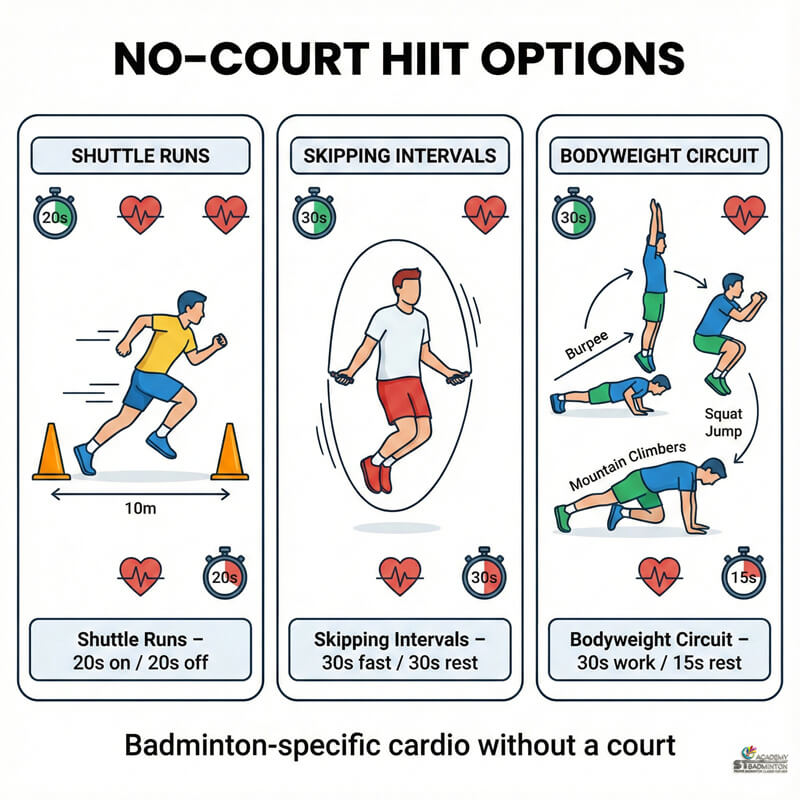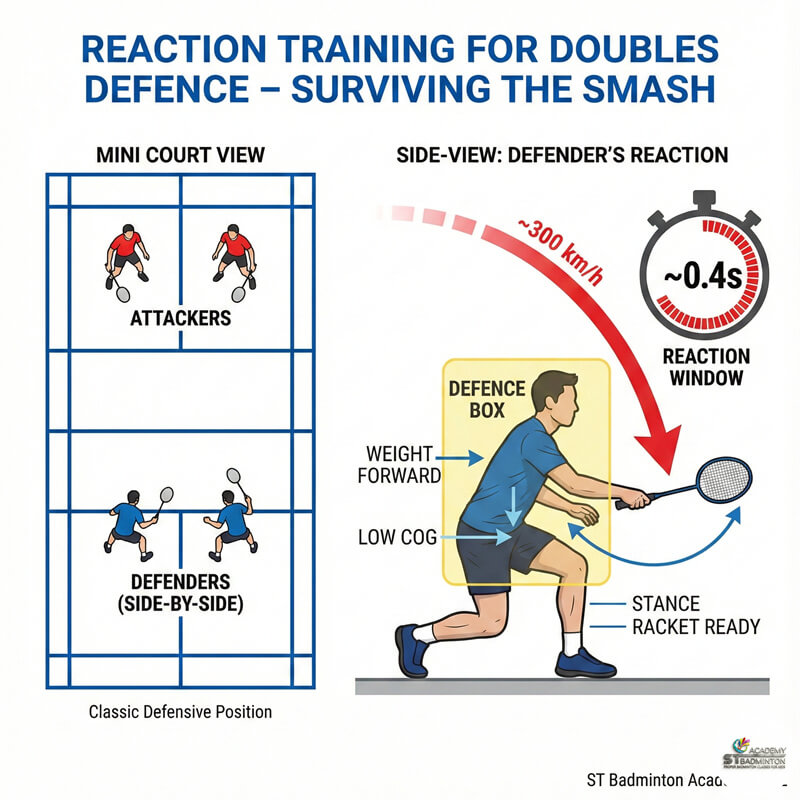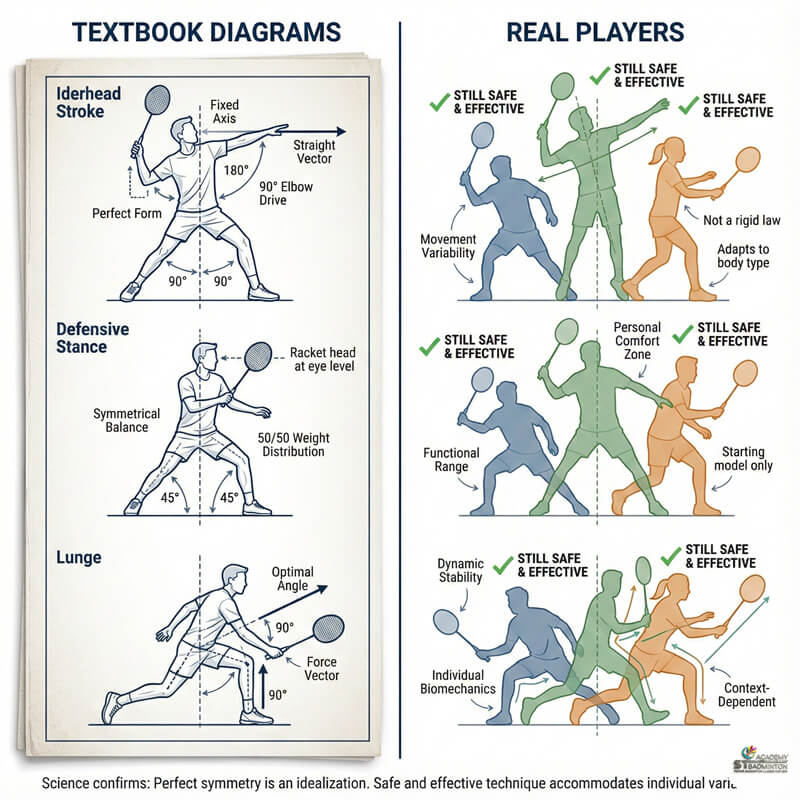5 Essential Badminton Drills for Beginners (Malaysia & Singapore)
As a coach working with beginners in Malaysia and Singapore, I often see players jump straight into games without learning any basic drills. Once we slow down and build proper foundation step by step, their control, movement and confidence change completely within a few months. This guide helps beginners of all ages in Setapak, Wangsa Maju, Kepong, Cheras and surrounding areas learn the five essential badminton drills that build solid foundation faster than random casual play.
A certified badminton coach explains which beginner drills matter most, why they work better than unstructured rallies, and how to practise them correctly whether you are a kid, teen or adult starting badminton across Kuala Lumpur and Singapore.
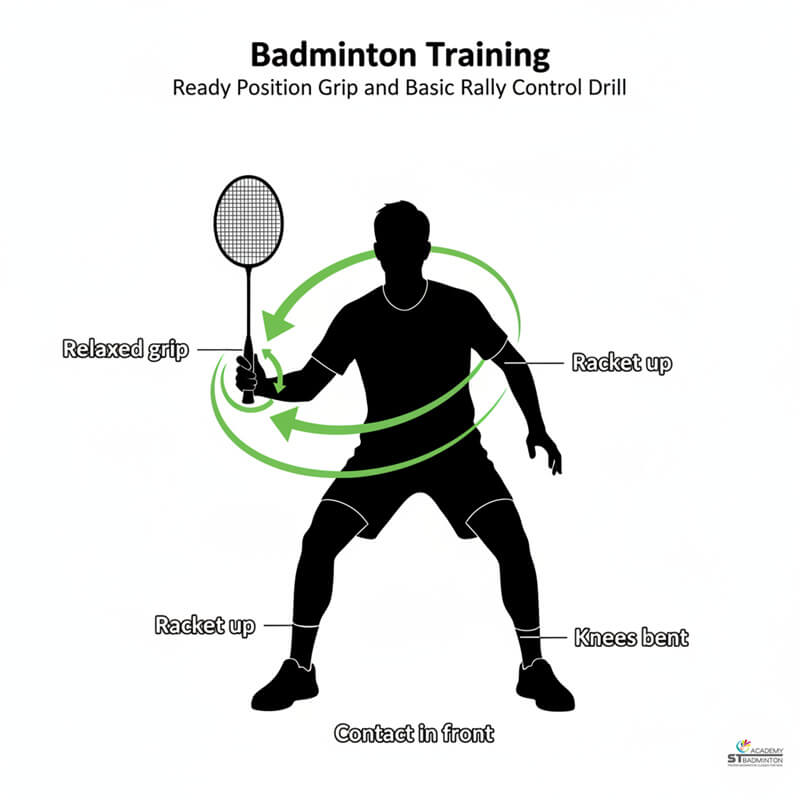
Essential Drill #1
Ready Position Grip and Basic Rally Control Drill
The foundation of all badminton skills begins with correct grip and ready position, which beginners in Malaysia and Singapore must learn before attempting any powerful shots or fast rallies. This essential drill teaches proper forehand and backhand grip changes, stable ready stance with knees slightly bent and racket up, and controlled contact point where the shuttle meets the strings consistently in front of the body.
Beginners from Setapak, Wangsa Maju and Cheras should start with slow cooperative rallies where both players focus only on clean contact and maintaining shuttle height at chest to shoulder level, aiming for ten to twenty consecutive hits without errors. Our certified coach at ST Badminton Academy emphasises relaxed grip that tightens only at impact, proper wrist position and body balance rather than rushing to hit hard or fast during this foundational stage.
Many new players across Kuala Lumpur and Singapore skip this seemingly simple drill and jump straight into games, but without solid grip and ready position habits their progress remains slow and inconsistent no matter how much they play casually.
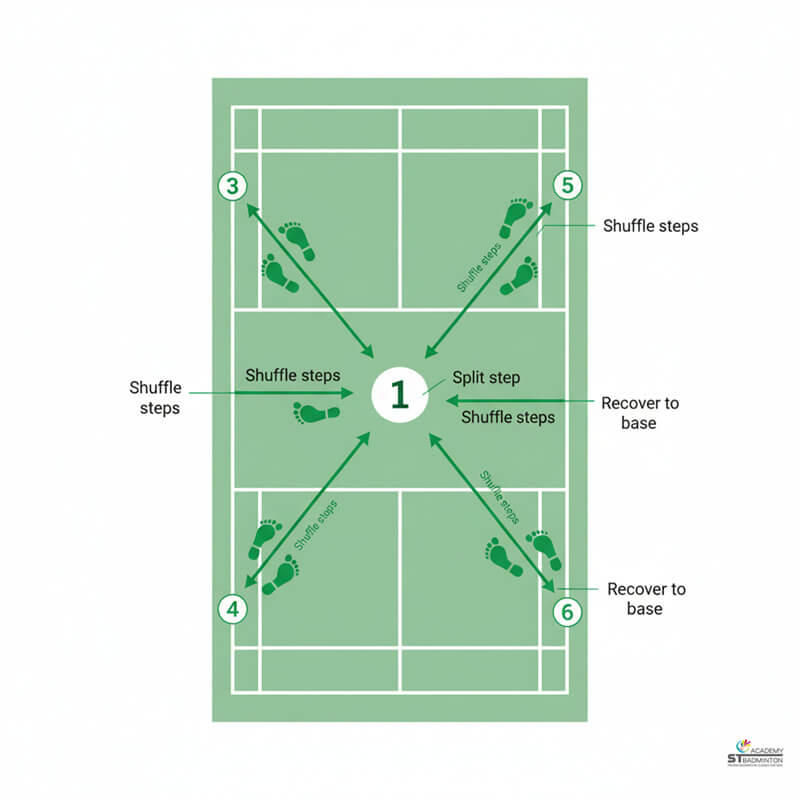
Essential Drill #2
Basic Footwork and Movement Pattern Drill
Footwork is the foundation that allows all other badminton skills to function properly, yet many beginners in Kuala Lumpur and Singapore ignore movement training and focus only on hitting shuttles. This essential drill teaches the six-point footwork pattern where players start from centre base position and move systematically to front corners, back corners and side positions, then recover back to base after each movement using proper steps and body positioning.
Players from Selayang, Kepong and Ampang can practise this footwork drill even without a partner or shuttlecock by doing shadow movement around the court, focusing on small split step before moving, keeping body facing the net, using shuffle and lunge steps correctly, and recovering quickly to central ready position. Our coaching team at ST Badminton Academy emphasises that good footwork makes every shot easier and more powerful, while poor footwork forces players to stretch awkwardly and hit weak shots even when they know correct stroke technique.
Beginners who dedicate ten to fifteen minutes per session to structured footwork drills develop much faster court coverage and shot consistency than those who only play casual games without deliberate movement practice.
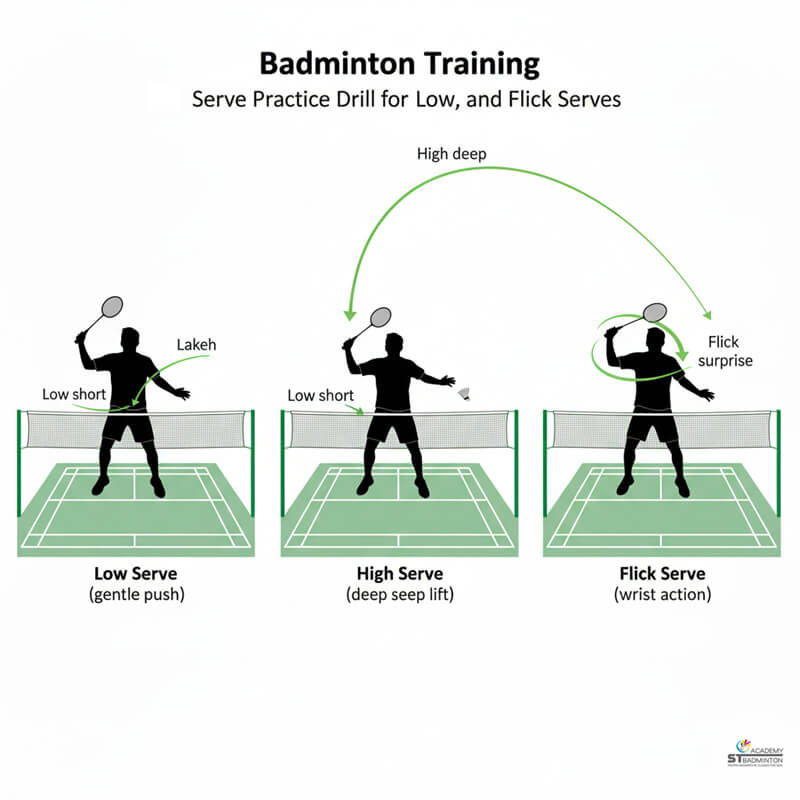
Essential Drill #3
Serve Practice Drill for Low High and Flick Serves
A reliable serve is one of the most important skills for badminton beginners in Malaysia and Singapore because every rally starts with a serve, yet many new players neglect dedicated serve practice and struggle with consistency during actual games. This essential drill involves standing in the correct service position and hitting ten to twenty consecutive low short serves to a specific target area in the opponent service box, focusing on gentle contact, consistent trajectory and landing the shuttle just over the net with minimal height.
Players from Sentul, Gombak and Cheras can practise serve drills alone at home or in community halls by placing targets on the floor and repeatedly serving to those spots, gradually adding high long serves and flick serves once basic low serve control is stable. Our certified coach at ST Badminton Academy teaches beginners the legal serving rules for singles and doubles matches, proper serving stance with one foot stationary, and the difference between hitting the shuttle base versus feathers for different serve types.
Working adults from Petaling Jaya, Subang Jaya and Singapore areas like Jurong or Clementi often appreciate that serve practice requires no partner and can be done during short solo training sessions before or after work.
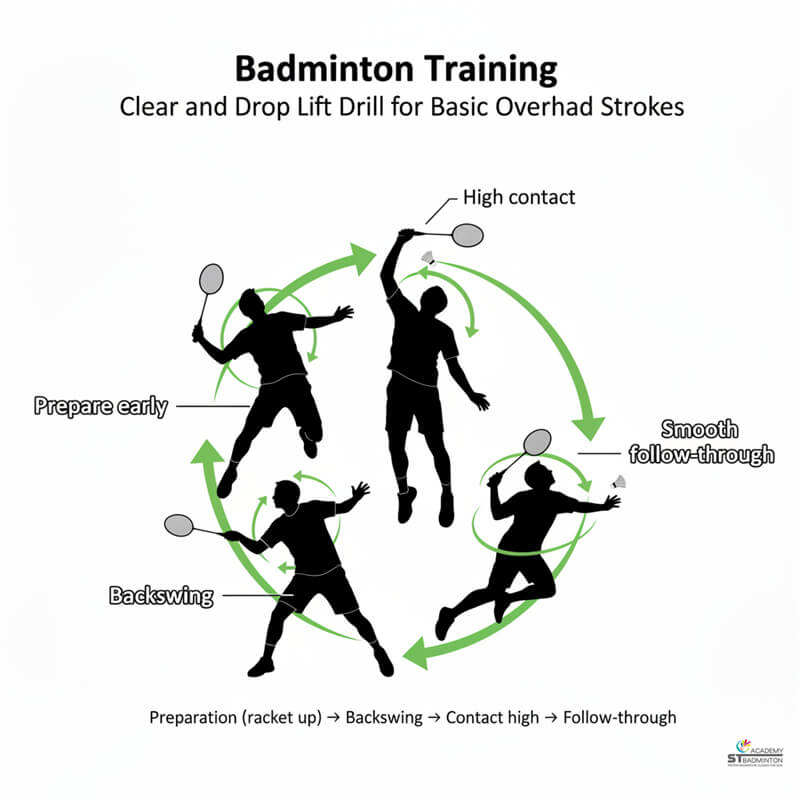
Essential Drill #4
Clear and Drop Lift Drill for Basic Overhead Strokes
Learning basic overhead strokes through structured clear and drop drills helps beginners in Kuala Lumpur and Singapore develop proper racket swing path, contact point and follow through for the most common badminton shots played from the back court. This essential drill involves two players exchanging clears where both hit high deep shots to the back corners, or one player clears while the other drops, creating a simple repetitive pattern that builds consistent stroke technique without the pressure of winning points.
School team players from Wangsa Maju, Ampang and Singapore areas like Bishan or Toa Payoh should focus on maintaining ten to twenty consecutive rally exchanges with correct overhead form rather than trying to hit fast or deceptive shots during this beginner stage. Our coaching team at ST Badminton Academy teaches the difference between defensive clears that go high and deep, attacking clears with flatter trajectory, and gentle drop shots that fall just over the net, helping beginners understand when each stroke is appropriate.
The key coaching points include preparing early with racket up, rotating the body and shoulders, contacting the shuttle at the highest point with elbow extension, and following through smoothly across the body rather than stopping the racket abruptly after contact.
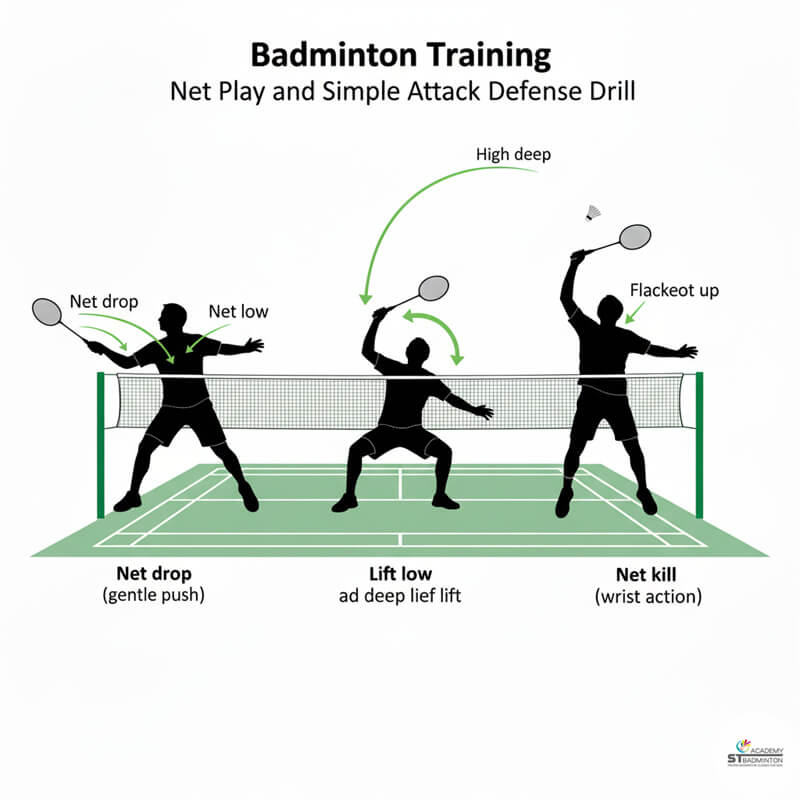
Essential Drill #5
Net Play and Simple Attack Defence Drill
Net play skills separate players who can only hit from the back court from those who control the entire badminton court effectively, making net drills essential for beginners in Malaysia and Singapore who want complete game development. This drill teaches gentle net drops where players softly tap the shuttle just over the net with minimal backswing, lifting from net to back court when the shuttle is below net height, and simple net kills when the shuttle is high enough to push downward with control.
Beginners from Setapak, Petaling Jaya, Puchong and Singapore office areas can start with basic net-to-net rallies where both players stand close to the net and exchange soft controlled shots, focusing on gentle touch, racket angle and stable body position rather than trying to win the point. Our certified coach at ST Badminton Academy adds a simple attack-defence pattern where one player hits light smashes or drives from mid-court while the other lifts or blocks, teaching beginners how to respond appropriately to different shot types.
Players from Kepong, Cheras and areas around Ang Mo Kio or Yishun who practise these net and attack-defence drills regularly develop much better court awareness and shot selection compared to those who only play random games without structured pattern practice.
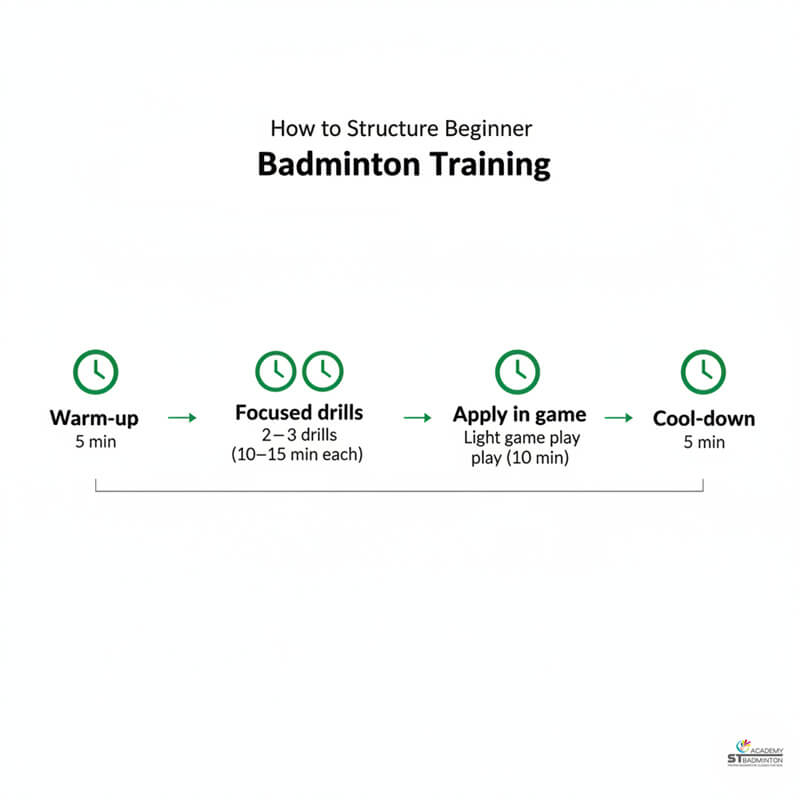
Training Guidance
How to Structure Beginner Badminton Training Sessions
Beginners in Kuala Lumpur and Singapore see fastest improvement when they practise two to three times per week for thirty to sixty minutes per session, structuring each session with warm-up, focused drill work on two to three of the essential drills, and finishing with light game play that applies what was practised. A simple training session might start with five to ten minutes of light movement and dynamic stretching, then ten minutes each on footwork drill and serve practice, followed by fifteen minutes of clear-drop rally drill with a partner, and conclude with ten to fifteen minutes of relaxed game play.
Players from Selayang, Gombak and areas around Toa Payoh or Tampines should rotate which drills they emphasise each session rather than trying to cover everything every time, allowing deeper focus and better skill retention. Our coaching team at ST Badminton Academy helps beginners design realistic weekly training plans that fit around school, work and family commitments while still providing enough consistent practice to build solid foundation.
Common beginner mistakes include holding the grip too tight throughout the rally, standing flat-footed without ready position, swinging only with the arm instead of using body rotation, and chasing shuttles without maintaining central base position, all of which can be corrected through patient drill practice with proper coaching feedback.
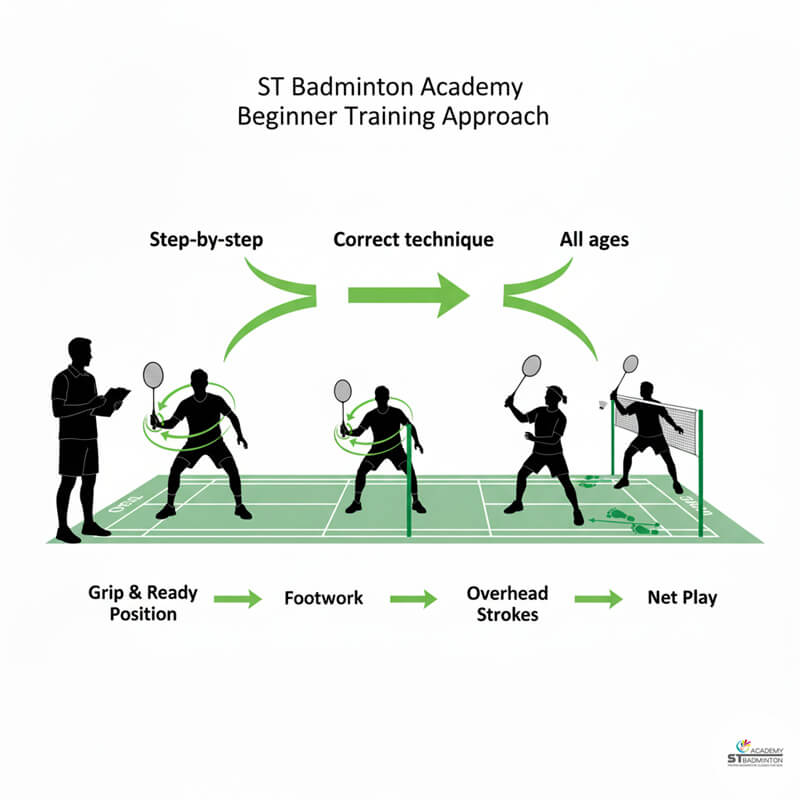
Why Choose Us
ST Badminton Academy Beginner Training Approach
At ST Badminton Academy in Kuala Lumpur, we teach beginners of all ages through structured drill-based training that builds proper foundation in grip, footwork, serve and basic strokes before moving to advanced techniques or competitive play. Our certified coach guides kids, teens and adults through the five essential beginner drills systematically, correcting small details in body position, racket angle and timing that make the difference between slow struggling progress and steady confident improvement.
Players from Setapak, Wangsa Maju, Selayang and surrounding areas learn that consistent drill practice with proper coaching feedback produces faster results than years of casual game play without structure or correction. We design simple realistic training plans that fit into busy weekly schedules for working adults and school students, combining solo drills that can be done at home with partner drills during class sessions.
Families from Cheras, Ampang, Petaling Jaya and Singapore areas like Hougang, Sengkang or Punggol appreciate that we focus on building solid technique step by step rather than rushing beginners into matches before they are ready. Contact us to learn how structured beginner drill training can help you or your child develop proper badminton foundation across Malaysia and Singapore.
FAQs: Essential Drills For Badminton Beginners
Here are answers to common questions about essential badminton drills for beginners in Malaysia and Singapore.
What are the best badminton drills for complete beginners in Kuala Lumpur and Singapore?
The five essential drills are ready position and grip control, basic footwork patterns, serve practice for all serve types, clear and drop overhead strokes, and net play with simple attack-defence. Beginners in Setapak and Wangsa Maju should start with slow cooperative versions focusing on technique rather than speed. Our certified coach at ST Badminton Academy teaches these drills systematically to kids, teens and adults, ensuring proper foundation before advancing to more complex skills or competitive play.
How many drills should I do in one badminton training session in Malaysia?
Focus on two to three drills per session for thirty to sixty minutes total training time, allowing ten to fifteen minutes per drill with proper warm-up before and light game play after. Players in Kuala Lumpur and Selangor who try to cover all five drills every session often rush through each one without quality practice. Our coaching team recommends rotating emphasis across different sessions throughout the week, ensuring each drill gets adequate attention over time without overwhelming beginners with too much information.
Can I practise badminton drills alone at home in Singapore?
Yes, footwork drills can be done through shadow movement without shuttles, serve practice requires no partner if you have space and targets, and grip plus ready position can be trained alone with a racket. Players in Jurong, Clementi and Bishan use wall rallies for basic control when partners are unavailable. However, clear-drop and net play drills need a partner for proper practice. ST Badminton Academy offers structured classes where beginners can practise partner drills with coaching supervision and correction.
Are these beginner drills suitable for both kids and adults in Malaysia?
Yes, the five essential drills work for all ages from kids to working adults, with coaching adjustments for physical capability and learning pace. Children in Selayang, Sentul and Gombak may need shorter drill sessions with more rest, while adults can sustain longer focused practice. Our certified coach at ST Badminton Academy adapts drill complexity and intensity to match each beginner’s age, fitness level and coordination, ensuring everyone builds proper foundation regardless of when they start learning badminton.
How long will it take to see improvement from beginner badminton drills in Singapore?
Most beginners in Petaling Jaya, Subang Jaya and Singapore areas like Ang Mo Kio or Yishun notice clearer control and more consistent rallies within four to six weeks when practising two to three times weekly with proper drill structure and coaching feedback. However, progress depends on practice quality and frequency rather than just time elapsed. Our coaching team emphasises that rushing through drills without correct form produces slow improvement, while patient focused practice with attention to technique details yields steady visible progress.
Should beginners play games or focus only on drills in Kuala Lumpur?
Beginners should dedicate most training time to structured drills but include short light game play at the end of each session to apply what was practised in rally situations. Players in Kuala Lumpur and Selangor who only play games without drill practice develop bad habits and progress very slowly. Our certified coach at ST Badminton Academy recommends spending thirty to forty-five minutes on focused drills then ten to fifteen minutes on relaxed game play during each session for balanced skill development.
How do I avoid injury when practising beginner drills in Malaysia?
Always warm up properly with light movement and dynamic stretching before drills, start slowly with control rather than maximum speed or power, and stop if you feel joint pain or unusual discomfort. Players from Cheras, Ampang and Puchong should avoid overtraining by limiting sessions to three times weekly with rest days between. ST Badminton Academy teaches proper technique for each drill including correct body position and movement mechanics that reduce strain on knees, shoulders and back during repetitive practice.
When should I join structured beginner classes at a badminton academy in Singapore?
Join structured classes from the very beginning if possible because certified coaches correct technique details that are difficult to identify and fix alone through self-practice. Singapore areas like Bishan, Hougang and Sengkang offer community classes but working with experienced coaching at ST Badminton Academy ensures drills are done correctly from day one. Beginners who start with proper coaching avoid developing bad habits that take months to unlearn later, making early investment in quality instruction worthwhile for long-term skill development.
Can working adults still start as complete beginners with these drills in Malaysia?
Absolutely, many working adults from Setapak, Wangsa Maju and Selayang start badminton in their twenties, thirties or even later and develop good skills through consistent drill practice with proper coaching. Our coaching team at ST Badminton Academy works with adult beginners regularly, designing realistic training schedules that fit around work and family commitments. Adults often progress efficiently because they can focus on technical instructions and practise with patience, building solid foundation that supports enjoyable recreational play for years to come.
Beginner Drill Training in Action
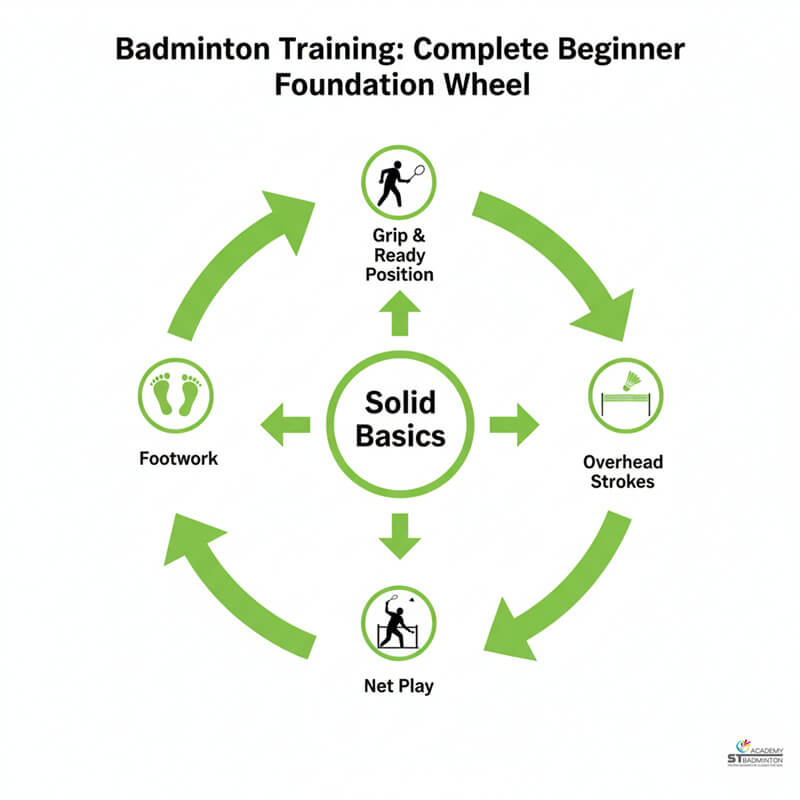
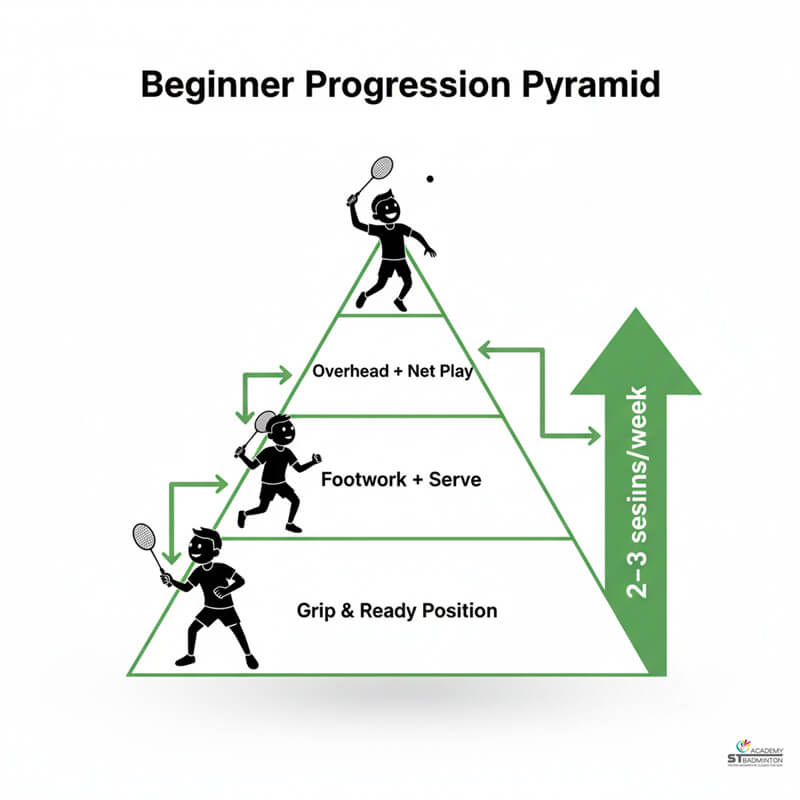
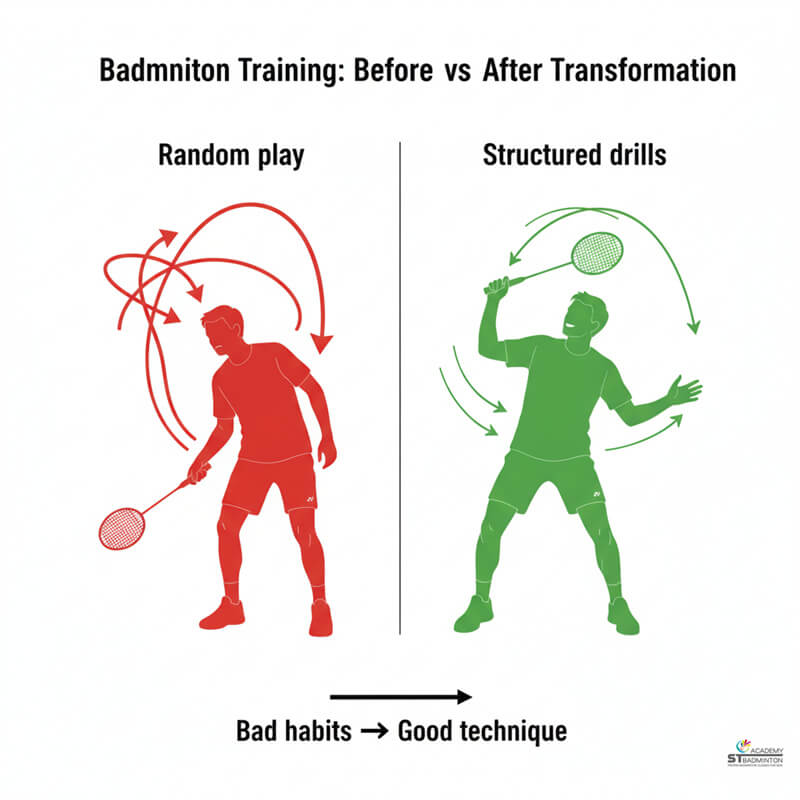
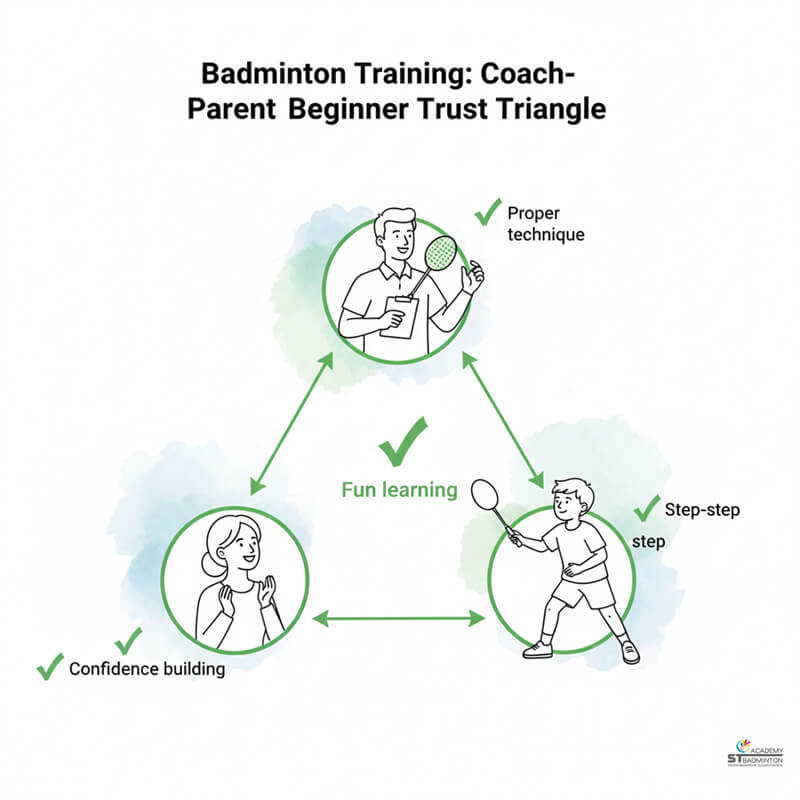
Benefits of Structured Beginner Drills
Learning badminton through the five essential beginner drills helps players in Malaysia and Singapore develop proper technique, consistent control and confident movement faster than years of random casual play. Our certified coach uses structured progressive training that builds solid foundation step by step for all ages.
| Learning Aspect | Random Casual Play Only | Structured Beginner Drills EFFECTIVE |
|---|---|---|
| Technique Development | Develop inconsistent bad habits that become automatic over time. No correction of grip, stance or stroke errors. | Build correct technique from day one with coaching feedback. Develop repeatable form through focused drill practice. |
| Learning Speed | Progress very slowly despite playing for years. Plateau at beginner level without improvement in fundamentals. | See visible improvement within four to six weeks. Develop solid foundation that supports continuous skill growth. |
| Footwork Quality | Stand flat-footed and lunge desperately. Poor court coverage and awkward body position for every shot. | Learn proper movement patterns through shadow footwork. Move efficiently with balance and quick recovery to base. |
| Shot Consistency | Hit some good shots randomly but cannot repeat them. Unreliable serve and basic strokes under pressure. | Build consistent serve and rally control through repetition. Develop reliable technique for all basic strokes. |
| Confidence Building | Frustration from losing points to errors. Avoid certain shots due to lack of practice and control. | Gain confidence through gradual mastery of each skill. Feel comfortable using all basic strokes during games. |
| Training Efficiency | Waste time repeating same mistakes without improvement. No clear focus or goals during casual sessions. | Make efficient use of limited training time. Clear purpose and measurable progress in every session. |
| Long Term Development | Reach skill ceiling quickly with weak foundation. Require months to unlearn bad habits before real progress. | Build strong platform for advanced skills later. Smooth progression to intermediate and advanced techniques. |
Beginner Badminton Training in Kuala Lumpur and Singapore
This guide helps beginners in Malaysia and Singapore understand which essential drills build proper badminton foundation and how to practise them correctly for fastest improvement. ST Badminton Academy provides structured beginner training for kids, teens and adults in Setapak, Wangsa Maju, Selayang, Kepong, Cheras and surrounding areas. If you want coaching that teaches correct technique step by step through the five essential drills rather than just casual game play that reinforces bad habits, contact us to learn how structured beginner training can help you or your child develop solid badminton foundation across Malaysia and Singapore.

